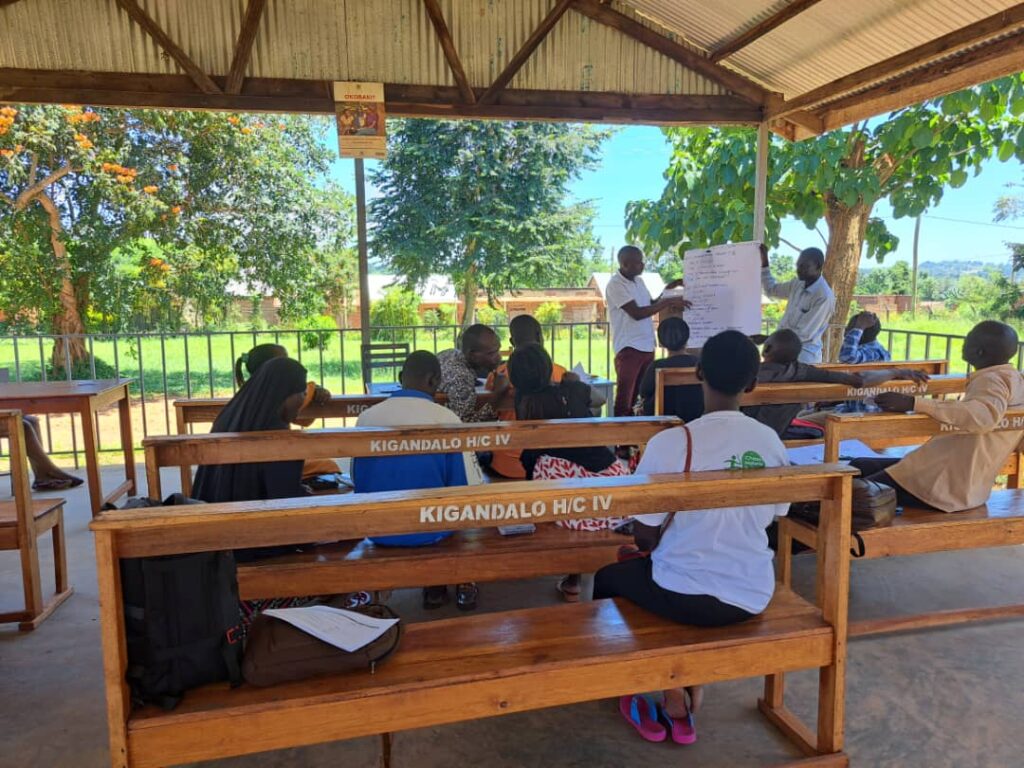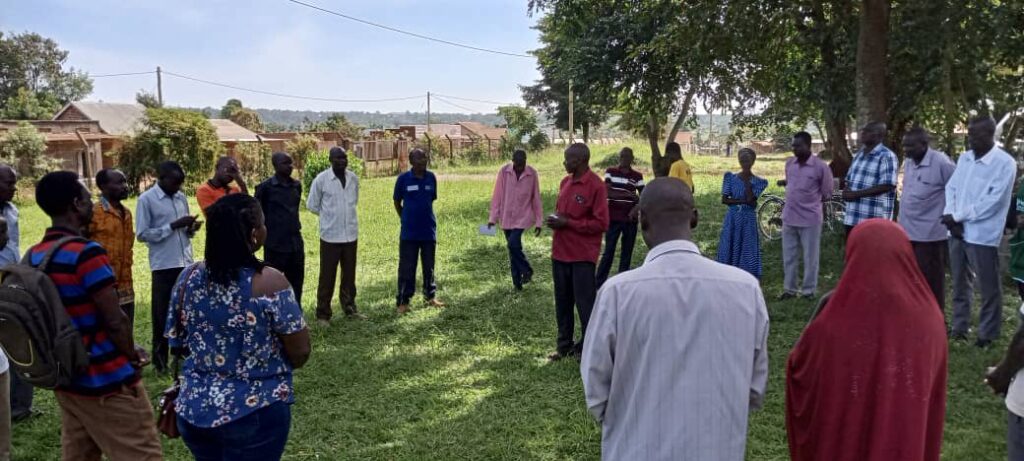More than Just a Cough: Uncovering Tuberculosis (TB) Solutions with WI-HER’s iDARE Methodology
By Flavia Mystica Atoo, WI-HER Gender and Youth Specialist

Uganda faces a significant challenge with tuberculosis (TB), with an estimated 91,000 new infections each year, approximately 32% of which are among individuals also living with HIV, according to the WHO. The fight against TB starts with the early identification and treatment of previously undiagnosed cases. Despite the severity of TB, its risks are often minimized within communities and dismissed as a simple cough treatable with over-the-counter medications or traditional remedies.
In response, the USAID Social Behavior Change Activity (SBCA) introduced WI-HER’s iDARE methodology in 2021, aiming to enhance TB case notifications among women and men. This initiative is part of a broader, five-year USAID-funded project operating on a national scale to provide technical assistance and support to national and district-level partners on social and behavior change (SBC) activities. The project is implemented by Johns Hopkins Center for Communication Programs, WI-HER, Busara, World Vision, and The Medical Concierge Group (TMCG). By collaborating closely with the consortium and playing a crucial role in incorporating gender, youth, and social inclusion (GYSI) considerations into programming, WI-HER ensures the effective integration of GYSI through the use of iDARE, leading to a more inclusive and effective fight against TB.
Using iDARE to Identify Barriers to TB Case Identification and Treatment
Our journey begins in the Bushenyi and Kabale districts in Southwestern Uganda, where initial assessments conducted by the two district local governments and implementing partners (IPs), including Local Partner Health Services (LPHS)-Southwest, revealed low TB notification rates and significant barriers to TB case identification and treatment. SBCA and the IPs supported the identification and training of the iDARE behavior change teams in two health facilities in the two districts. The teams then delved deeper, with support from SBCA and implementing partners, to apply iDARE to further unearth barriers not commonly discussed and deeply rooted in GYSI issues.
Among barriers to TB diagnosis and treatment were instances of gender-based violence (GBV) triggered by long wait times at health facilities; this environment fueled suspicions by some husbands that their wives were using these visits as a pretext to meet lovers, leading to domestic abuse upon their return. Additionally, cultural norms contributed to a reluctance among men to seek healthcare, viewing it as predominantly a domain for women. Women, on their part, often found their access to healthcare restricted without male consent or financial resources for transportation. Moreover, entrenched gender roles often viewed men’s presence at health facilities as a waste of time, prioritizing income generation over healthcare.
Due to these barriers, health facilities in the Bushenyi and Kabale districts faced challenges in reaching their TB case notification targets, set at three and four clients per quarter, respectively.
How iDARE Helped Inform SBCA Interventions
SBCA’s interventions included the distribution of tailored Information, education, and communication materials; the organization of village meetings; and the execution of mass media awareness campaigns. Through the use of iDARE, SBCA engaged community influencers as catalysts in employing simple yet effective culturally sensitive solutions. These strategies, developed by community influencers themselves, included ramping up community health education on TB, organizing community dialogues, conducting home visits to create awareness of and address GBV, targeting men with health information at local gathering spots, and integrating TB testing into community outreach to mitigate accessibility issues. Additionally, community influencers conducted community sample collection and intensified contact tracing after facility lab personnel/TB focal persons oriented the influencers on safe sample collection and handling.
Following these concerted efforts, the TB notification targets at Kyeizooba Health Center III in Bushenyi witnessed notable improvements, from 33% in March 2021 to a full 100% of their set targets by September 2021, while Maziba Health Center 4 in Kabale saw an increase from 25% to 75% within the same period. These interventions consistently enabled the teams to perform above their quarterly TB notification targets.
Scaling Up iDARE and Reaching More Communities

During an asset mapping activity, SBCA shared the results and SBC capacities of LPHS-Southwest with LPHS-East Central (EC). Encouraged by the LPHS-Southwest’s positive results, LPHS-EC approached SBCA for technical support to scale up the iDARE methodology to improve TB case notification in the East Central region. In collaboration with LPHS-EC, SBCA identified and trained 28 Village Health Teams (VHTs) and 20 community influencers in Kigandalo Sub County on the iDARE methodology. These trained individuals were supported to identify the key barriers hindering TB case notification within their communities, which included:
- TB Stigma and HIV Association: The stigma linked to TB, especially its association with HIV, discourages people from seeking TB tests for fear of being labeled as HIV positive.
- Limited knowledge of TB: A widespread lack of knowledge about TB leads to delays in seeking treatment or recognizing symptoms andsymptoms.
- Low-risk perception: TB is often perceived as a mere cough that can be treated with over-the-counter medicines. People, therefore, do not take preventive measures and only seek medical care when they are seriously ill.
- Cultural and Religious Beliefs: Preferences for traditional healers or religious remedies over modern medicine can prevent timely access to TB diagnosis and treatment.
- Accessibility to Health Facilities: Long distances to health centers deter people from seeking TB care.
- Health Facility Congestion: Overcrowding and long wait times at health facilities dissuade people from pursuing TB services, viewing it as a loss of valuable time that could be used for income-generating activities.
Co-creating Strategies and Solutions
To address these barriers, the iDARE team developed and implemented a variety of strategies aimed at increasing community awareness, identifying potential TB cases, and facilitating their access to diagnostic and treatment services. These strategies included intensified community sensitization through local platforms such as churches, mosques, village saving groups, and social gatherings and door-to-door campaigns to emphasize the importance of early TB detection and treatment, signs, symptoms, and risks associated with delayed diagnosis. Additionally, efforts were made to mobilize, identify, and refer presumptive TB cases to health facilities, alongside community sample collection initiatives to mitigate the challenges of distance and waiting times at health facilities.
SBCA, together with local partners, is committed to ongoing onsite coaching and mentorship for the trained teams to tackle emerging barriers, enhance their capacity to implement effective solutions, and monitor progress through the analysis of facility data. This collaborative approach not only sustains the gains made in TB case notification and treatment initiation but continuously adapts and refines strategies to meet the community’s evolving needs. Applying the iDARE methodology in various parts of Uganda represents a significant step forward in the global fight against TB, offering a replicable model for other regions grappling with similar challenges.